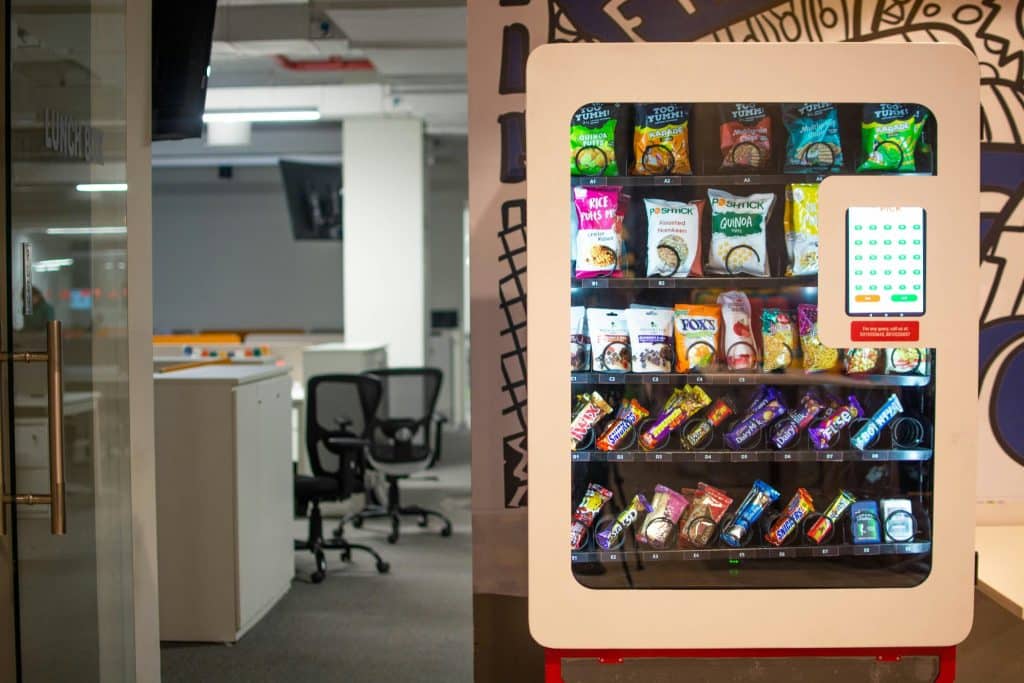In the digital age, vending machines have evolved from simple mechanical devices to sophisticated retail solutions, equipped with smart technologies and automated systems. These advancements have transformed vending machines into highly efficient, customer-centric platforms that offer a wide range of products and services. At the heart of these innovations is the software that powers them, ensuring seamless operation, enhanced user experience, and operational efficiency.
This blog explores the crucial aspects of maintaining and supporting vending machine software, from routine maintenance to integrating cutting-edge technologies.
Read more about our Smart Vending Solutions!
GET IN TOUCH
Get Free Consultation
Key Takeaways
- Importance of maintaining and updating vending machine software
- Best practices for scheduled maintenance and troubleshooting
- Enhancing user experience through smart technologies
- Future trends in vending machine software
Understanding Smart Vending Machine Software
Components and Architecture
Smart vending machines are complex systems powered by software that handles various tasks, from managing inventory to processing payments and offering interactive user interfaces. The architecture typically includes a central processing unit (CPU) that acts as the brain of the machine, software applications for operational functions, and connectivity options (like cellular, Wi-Fi, or Ethernet) for remote management and data analysis. Understanding how these components interact is crucial for diagnosing issues and performing effective maintenance, ensuring that each part of the vending machine operates in harmony with the rest.
Core Components of Smart Vending Machine Software
| Component | Feature |
| User Interface (UI) | Facilitates interaction between the machine and the user, displaying products and services. |
| Payment Processor | Handles transactions, including cash, credit/debit cards, and mobile payments. |
| Inventory Management | Tracks product levels and alerts operators when restocking is needed. |
| Remote Monitoring | Allows operators to oversee machine status, sales data, and maintenance needs remotely. |
| Security Module | Protects against unauthorized access and ensures data privacy and transaction security. |
Understanding the software architecture is crucial for effective maintenance. It involves not just the applications running on the machine but also how these components communicate with external networks and back-end systems for inventory management, sales tracking, and customer support.
Software Updates and Upgrades
Keeping vending machine software up-to-date is essential for several reasons. Firstly, updates can fix security vulnerabilities, protecting both the operator and the consumer from potential threats. Secondly, they can improve the machine’s efficiency, perhaps by optimizing the payment process or inventory management system. Finally, updates often introduce new features that can enhance the user experience, such as more payment options or interactive screens. Regularly scheduled updates ensure that vending machines remain competitive and continue to meet the expectations of modern consumers.

Regular software updates and upgrades are crucial for:
- Security: Patching vulnerabilities to protect against malware and hacking attempts.
- Efficiency: Optimizing operations, reducing energy consumption, and improving transaction speeds.
- Features: Adding new functionalities, such as touchless payments or interactive nutritional info.
List of Best Practices for Software Maintenance:
- Schedule regular software audits to identify update needs.
- Prioritize security patches and apply them as soon as they’re available.
- Test updates in a controlled environment before deploying across all machines.
Routine Maintenance for Peak Performance
Scheduled Maintenance Practices
Routine maintenance is vital for the longevity and reliability of vending machines. This includes software diagnostics to check for errors or malfunctions, updating the firmware to ensure the latest features and security patches are in place, and cleaning the data logs to prevent software slowdowns. Establishing a maintenance schedule can help vending machine operators avoid unexpected downtime, ensuring that machines are always ready to serve customers.
Preventive Maintenance Schedule Example:
| Frequency | Task | Description |
| Monthly | Software Health Check | Run diagnostics to identify and fix software issues. |
| Quarterly | Firmware Update Check | Review and apply firmware updates if available. |
| Annually | Full System Audit | Conduct a comprehensive review of all software components and functionality. |
Troubleshooting Common Issues
Familiarity with common software-related problems can significantly reduce downtime. For example, payment processing failures may be due to outdated software, while inventory discrepancies could stem from sensor malfunctions or software glitches. Developing a troubleshooting guide that addresses these common issues can empower operators to quickly restore service, minimizing any inconvenience to customers.
Troubleshooting Steps:
- Identify the issue through error codes or system alerts.
- Consult the vending machine’s troubleshooting guide for potential solutions.
- If unresolved, escalate to on-demand support services for further assistance.
Support Solutions for Automated Vending Machines
On-demand Support Services
Even with the best preventive measures, vending machines will occasionally require external support. On-demand support services, such as 24/7 help desks or remote troubleshooting, can quickly resolve issues without the need for a technician to physically visit the machine. This not only saves time and money but also ensures vending machines are back in operation as quickly as possible.
Access to on-demand support services ensures that any issues can be quickly addressed. This includes:
- Remote Troubleshooting: Technicians can remotely access the machine’s software to diagnose and fix issues.
- On-site Assistance: For hardware-related issues or when remote troubleshooting is insufficient.
Training and Documentation
Investing in comprehensive training programs and detailed documentation can greatly reduce the reliance on external support. Training operators to understand the software’s interface, features, and common troubleshooting procedures empowers them to address many issues independently. Well-organized and accessible documentation serves as a valuable reference tool, further enhancing the operator’s ability to maintain and support the vending machine software.
Proper training and comprehensive documentation empower operators to manage their machines more effectively.
Key Training Areas:
- Software operation and interface navigation
- Routine maintenance procedures
- Troubleshooting common software issues
Integrating Retail Vending Machines with Smart Technologies
Leveraging IoT and AI
The integration of the Internet of Things (IoT) and Artificial Intelligence (AI) has opened up new possibilities for vending machine operations. IoT connectivity allows operators to remotely monitor machine status, track inventory levels, and even adjust pricing or promotions in real time. AI can enhance the customer experience by offering personalized recommendations based on previous purchases or current trends. Together, these technologies can significantly improve operational efficiency and customer satisfaction.

The integration of IoT and AI technologies enables:
- Real-Time Inventory Management: Automatically tracking and managing stock levels.
- Predictive Maintenance: Using AI to analyze operational data and predict potential failures.
- Personalized Customer Experiences: AI algorithms can suggest products based on past user behavior.
Enhancing User Experience
Improving the consumer interaction with vending machines is a continuous goal. Software enhancements can lead to a more engaging and convenient user experience, such as touchless payments, voice recognition, or interactive screens that offer nutritional information or product recommendations. By focusing on user experience, operators can increase sales and foster customer loyalty.
Future Trends in Automated Retail Machine Software
Predictive Maintenance Using AI
AI and machine learning are set to revolutionize vending machine maintenance through predictive analytics. By analyzing usage patterns and machine performance data, AI can predict potential failures before they occur, allowing operators to proactively address issues and reduce downtime. This shift towards predictive maintenance represents a significant advancement in operational efficiency and reliability.
Innovations in Vending Machine Software
The future of vending machine software is likely to see further integration with emerging technologies. Blockchain could offer secure, transparent transactions, while augmented reality (AR) interfaces could provide interactive product information or advertisements. Continued innovations in software will drive the evolution of vending machines, making them more interactive, efficient, and integrated into the daily lives of consumers.
Conclusion
As vending machines become increasingly sophisticated, the importance of maintaining and supporting their software cannot be overstated. By staying current with software updates, adhering to routine maintenance schedules, leveraging smart technologies, and preparing for future trends, vending machine operators can ensure their machines meet the high expectations of today’s consumers. In doing so, they not only enhance the user experience but also secure a competitive edge in the fast-evolving world of automated retail.
Frequently Asked Questions:
How often should vending machine software be updated?
Software updates should be performed regularly, with critical security updates applied as soon as they become available. A monthly check for updates is a good practice for non-critical updates.
Does Primi Digital provide 24/7 support for updates and maintenance of their smart vending software?
Absolutely! We take our role as a smart vending solution provider very seriously. With Vendi360, customers get real-time analytics that monitor and manage the machine 24/7. Our security updates are regular, and we also provide round-the-clock support for any issues that may be encountered.
What are the most common issues faced by vending machines?
Common issues include payment processing errors, inventory tracking discrepancies, and connectivity problems.
Can AI really predict vending machine failures?
Yes, through data analysis and pattern recognition, AI can forecast potential machine failures, allowing for preemptive maintenance.
What future technologies could impact vending machines?
Future technologies like blockchain for transaction security, AI for personalized shopping experiences, and AR for interactive displays are expected to significantly impact vending machines.
